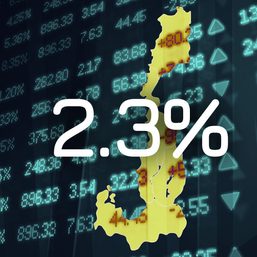SUMMARY
This is AI generated summarization, which may have errors. For context, always refer to the full article.
![[ANALYSIS] The hunt and drawdown recovery rate table](https://www.rappler.com/tachyon/2023/03/TL-hunt-drawdown-recovery-table-March-10-2023.jpg)
In the jungle, offense over defense seems to be the norm of life: a mantra of survival for every living thing in the wilds for a vigorous life.
But this doesn’t seem to hold when investing in the market. As you will see later on, defense is better than offense. The so-called “Recovery Table” below will show you why.
For this reason, it might be best to first take a look at the recovery table before we go on in the review of trading systems, as promised in my last article.
But first things first. Let’s look at what is going on in the market.
In last week’s trading results, the market again closed lower at 6,556.37 of the PSEi, again settling with a negative loss of 30.53 points or 0.46%. This further loss slashed the market’s year-to-date gains to only 88.98 points or 1.36% before it goes into negative territory.
In this otherwise disappointing performance of the market last week, the curious plays of its underlying variables are interestingly good. Take for example the big selloff on February 28, a Tuesday. Total value turnover rose to P31.01 B. Their participation was inordinately high at 73.29% of total market value turnover.
In addition, they were clearly net sellers. But the following day, Wednesday, March 1, the market reversed direction to end in positive territory. This end-of-day closing uptrend was carried all the way up to the end of the week on Friday, March 3.

The total gains in said three days were visibly not enough to wipeout losses. But it is interesting to note that the market’s fall was getting contained by the impact of positive sentiments of locals that emerged as a significant variable at play since the 4th week of the trading year.
It continued to lessen the impact of the selling bias of foreign investors, which rose to an average of 59.86% of total value turnover for the week. Normally, at this level of market participation, they would have easily dictated how the market should end. But this did not happen. The market closed higher daily since March 1.
Balance of bears
The market continued to move higher again on Monday, March 6. The advance, however, was once again slight. It ended with a gain of 15.75 points or 0.23 percent when it settled at 6,671.12 of the PSEi. Likewise, volume and value turnover were clearly low, especially for total value turnover which was equivalent to P4.751 B only.
A low value turnover with a positive market close could only mean that sellers were no longer willing to sell lower. In other words, there is now a paucity of shares for sale.
It would have been different if the market closed in the opposite direction with a low total market transaction as above. In this case, the supply of shares for sale is not a problem. They could be described as abundant. But sellers could hardly find buyers, who at this time are maybe opting to stay in the sidelines or plainly staying out of the market for the meantime.
This is known as the state of balance of bears (sellers) and bulls (buyers), in technical terms. Technical analysts bring this further to what they call “overbought” or “oversold” stocks. In simple terms, an oversold stock is considered worth more than its present trading price, while an overbought stock is considered worth less than its current price. (We’ll have more of this subject as we take a look at technical analysis on stock prices and price directions.)
By the way, the market continued to close higher with slight gains on March 7 and 8, again on low total value turnover of P5.51 B and P5.46 B, respectively. Curiously, foreign investors turned to be net buyers this time as they maintained a high market participation equivalent to about half of total market transactions.
Better-than-expected earnings and ‘BuY advisory’
Better-than-expected earnings reports and “BuY advisory
Looking closer at news reports, you may find the answer. Investors are momentarily setting aside their fears of inflation and other macro-economic woes in and out of the home front for favorable 2022 financial performance reports which started to trickle in lately.
Headline inflation report slowed down to 8.6% in February from 8.7% in January. Emboldened, the market is now entertaining a lower inflation rate for the coming months.
Market strategist and chief trader of H.E. Bennett Sec., Joel de la Pena, is especially elated by the developments in Petron Corporation (PCOR). PCOR declared cash dividends in the face of a two-year streak of profitable operation. Universal Robina Corporation (URC) likewise submitted a similar better-than-expected earnings performance report at the same time announced the declaration of cash dividends, too.
BDO Unibank, Inc. even announced increasing quarterly cash dividends amid strong operating performance. International Container Terminal Services, Inc. (ICT) also reported a good year, declaring cash dividends, as well.
Jofer Gaite, a stockbroker of BA Securities Inc., whose father was a good friend of mine and known as head honcho of one of a leading public fund institution in the country before, agree to the “buy” advisory of some stockbrokerage houses already. He also agrees with the hunt for Ayala Corporation (AC), ACEN CORPORATION (ACEN), Manila Electric Company (MER), Bank of the Philippine Islands (BPI), Metropolitan Bank & Trust Company (MBT), GT Capital Holdings, Inc. (GTCAP), SM Investment corporation (SM), Metro Pacific Investments Corporation (MPI), Globe Telecom (GLO), PLDT, Inc. (Tel), Puregold Price Club, Inc. (PGOLD), to mention a few.
Consulting the “crystal balls” used by legendary traders in the early part of the last century, whose basic formulas have been turned into exotic paradigms in technical analysis in the price of stocks and on market direction, these stocks have potential price upsides from a low of 20.0% to as high as 50.0 percent.
Gaite, however, resonates with cautious advice in the “buy” advisory citing that the price multiples (P/E ratio) in nearby regional bourses (which are larger and even more liquid than our market) have much lower stats compared to “the relatively high 14.56x p/e multiple of the local market.”
In this connection, let’s go back to recovery table as you mull to start your hunt.
In essence, the recovery table will show you how much you have to gain to recover a loss. On the flip side, it will tell you how much losses you can take. As presented from one source, this is how it works:
As you can see, the chart shows the exponential return you need to recover. It also helps to show you the level of loss you can reasonably play before you need to fold. This also explains I said that “defense is better than offense” when investing in the market. We’ll talk more about this later on.
Incidentally, the bourse kicked off on Thursday, March 9, with its three-day “PSE Investment Expo 2023” forum for its 2023 economic and market outlook. – Rappler.com
The article has been prepared for general circulation for the reading public and must not be construed as an offer, or solicitation of an offer to buy or sell any securities or financial instruments whether referred to herein or otherwise. Moreover, the public should be aware that the writer or any investing parties mentioned in the column may have a conflict of interest that could affect the objectivity of their reported or mentioned investment activity. You may reach the author at densomera@yahoo.com.
Add a comment
How does this make you feel?
![[In This Economy] Runaway rice prices are making inflation higher than it needs to be](https://www.rappler.com/tachyon/2024/02/tl-rice-prices.jpg?resize=257%2C257&crop=560px%2C0px%2C720px%2C720px)
![[ANALYSIS] A soft and range-bound stock market that has not lost its luster](https://www.rappler.com/tachyon/2024/02/TL-market-soft-range-bound-February-9-2024.jpg?resize=257%2C257&crop_strategy=attention)
![[In This Economy] Looks like PH economy will never get back on track. Here’s the data.](https://www.rappler.com/tachyon/2024/02/20240202-PH-economy-back-on-track.jpg?resize=257%2C257&crop=289px%2C0px%2C720px%2C720px)


There are no comments yet. Add your comment to start the conversation.